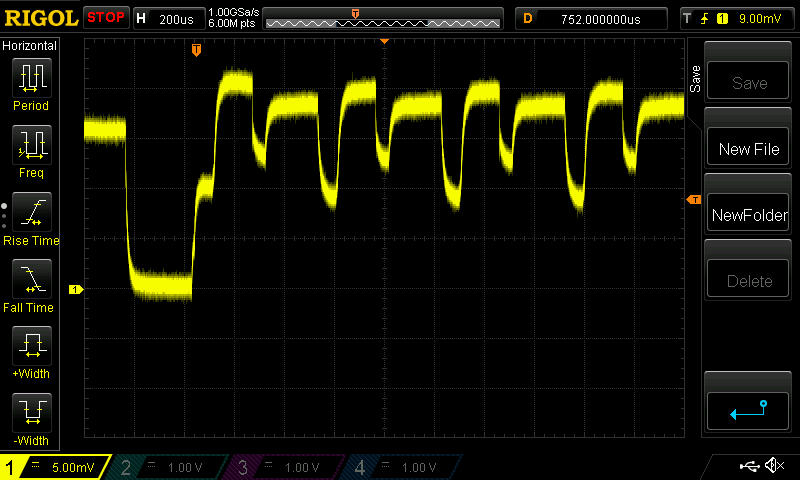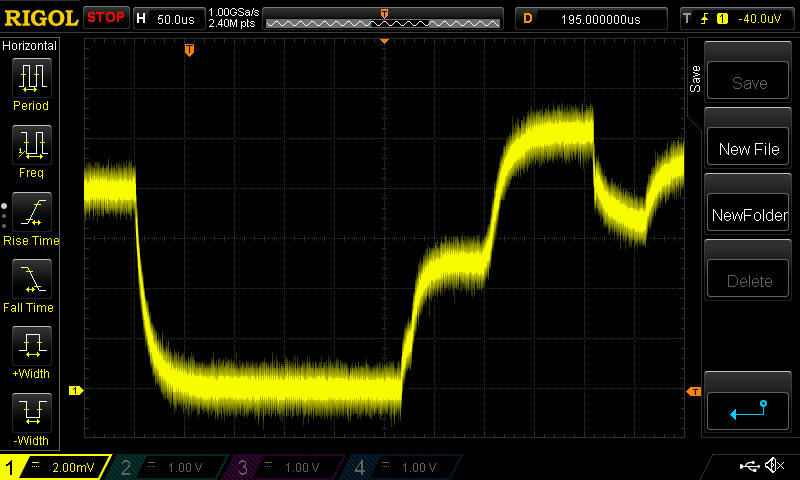Which are the *best* NRF24L01+ modules?
-
That's great!
The red module I tested (above) also used 1242AF. So, asuming the NRF chip in the Itead is genuine (which seems increasingly likely), then proportionately speaking, we're getting similar measurements.
Aside from the Picoscope, what is your test setup? You don't seem to be experiencing the fat scope lines that I am. Where is the NRF module in your photo? Is it being levitated by the wires in the photo? I'm surprised the wires don't seem to be picking up noise.
-
That's great!
The red module I tested (above) also used 1242AF. So, asuming the NRF chip in the Itead is genuine (which seems increasingly likely), then proportionately speaking, we're getting similar measurements.
Aside from the Picoscope, what is your test setup? You don't seem to be experiencing the fat scope lines that I am. Where is the NRF module in your photo? Is it being levitated by the wires in the photo? I'm surprised the wires don't seem to be picking up noise.
@NeverDie I added it to my previous post.
Overview of whole setup:
I never had issues with the wires picking up noise; at least not enough to distort communication. They're approx. 20cm long.
One more:
Module with nRF marked 1322DQ, supposedly genuine.
Also 11.2mATried it with another, random 1242AF, which gave 21.4mA
-
Exactly which USB isolator are you using? Sounds like I should get myself a couple in case I ever need to do this again.
-
Exactly which USB isolator are you using? Sounds like I should get myself a couple in case I ever need to do this again.
@NeverDie A Chinese clone of this circuit: https://www.circuitsathome.com/measurements/usb-isolator
The power socket is used to power the isolated USB side.
Beware this isolator ca only handle FullSpeed (12MBit/s), so not USB 2.0 HighSpeed (480MBit/s).
This prevents me from isolating my USB scope with it... -
Your setup roughly resembles my first attempt, where I was also using an Uno. However, I was overwhelmed with noise, which made me try the RFToy. I wasn't using isolators, though. I'm glad you got yours working, because it means that just about anyone with isolators and a scope can maybe do this test for themselves. As illustrated by you, the setup if pretty easy to follow. Good job!
P.S. Does using ribbon cable, as you are doing, rather than individual Dupont wires (as I did when I tried using the Uno) also help with controlling noise?
-
Interestingly, the USB cable that came with my Rigol has big ferrite cores on both ends of it. So, that probably helps as well.
-
Actually, you could just power that arduino using a battery. Right? Having the isolator is nice, in that you can monitor what's happening, but not strictly necessary.
So, really, I guess anyone with an o-scope can do this test, which is great!
-
Actually, you could just power that arduino using a battery. Right? Having the isolator is nice, in that you can monitor what's happening, but not strictly necessary.
So, really, I guess anyone with an o-scope can do this test, which is great!
-
@NeverDie correct!
With some simple hardware the uno could measure the current by itself and determine the maximum current used!
This has potential! -
It turns out my scope can do better than I thought. Here's the blob module again, but this time at 5mv/div.


So, I may be able to use an even smaller resistor, because now I can go down to 1mv/div, whereas before it seemed it wouldn't let me go lower than 10mv/div. Hopefully that will help improve my measurement accuracy.
-
-
It turns out my scope can do better than I thought. Here's the blob module again, but this time at 5mv/div.


So, I may be able to use an even smaller resistor, because now I can go down to 1mv/div, whereas before it seemed it wouldn't let me go lower than 10mv/div. Hopefully that will help improve my measurement accuracy.
-
@NeverDie transmission takes 233us in my measurements. What's the hdiv on your scope? 500/200us?
-
-
@Yveaux said:
@NeverDie any chip. Transmission time if identical every time.
Here's my best picture of the start of the transmission cycle for the blob module. I'm not sure where to call the actual start of it though, but we need to agree on that if we're going to compare numbers without pictures.

It's labeled on the upper bar (just to the right of the red "STOP") 50us/div
I modified the resister to be 1/2ohm, so now the vertical is 4ma/div, because it's 2mv/div vertical. Make sense? -
@Yveaux said:
@NeverDie any chip. Transmission time if identical every time.
Here's my best picture of the start of the transmission cycle for the blob module. I'm not sure where to call the actual start of it though, but we need to agree on that if we're going to compare numbers without pictures.

It's labeled on the upper bar (just to the right of the red "STOP") 50us/div
I modified the resister to be 1/2ohm, so now the vertical is 4ma/div, because it's 2mv/div vertical. Make sense?@NeverDie your horizontal scale is very different from what I measure.
The initial low-level part in the last scope picture shows only part of what you identify as transmission time, while it already lasts roughy 250us. That's more than the whole transmission time I measure!
We're definitely measuring differently.
Quickly off my head: a single message is 14 bytes long (see the sniffer capture above). At 1mbit this will take 14*8/1mbit=112 us. Add some time for startup, preamble, shutdown etc. and I think total time will be in the order of 233us, as I measured.Could you try running the sketch I put on github to compare things? Probably you will only have to change cs/ss pins to run it (I stick to the default mysensors connections)
It will also toggle a digital output on pin 3 before/after transmission which you can put on the scope together with the current measured, to have a reference when actual transmission takes place.Tonight (in 12 hours or so) I can do some more measurements if necessary.
-
I just now noticed where you put your markers on your o-scope plot. There are two voltage increases, the second settles out higher than the first, and it looks like you're counting both. I would guess transmission doesn't really start until the higher voltage is reached, though, wouldn't you? That also is a better match to your 112us number. Perhaps the lower voltage corresponds to loading the buffer or something like that that doesn't need the higher transmit power.
If you don't mind my asking, why the interest in the transmission length? Doesn't it have to be pretty similar from one type of chip to another, or else they won't interoperate?
-
I think that's probably what's happening. I'm running on an 8Mhz Pro Mini (effectively), and you're running on a 16Mhz Uno. So, your first hump takes about half the time mine does ( is that right?), whereas both our second humps should take about the same amount of time. Ahhhhh..., except they don't. Your second hump appears to take longer than my blob module's second hump does. Mine is about 100us, and yours is about 150us? Is that what interests you?
-
We would expect the data transmission per se to include a fixed prefix byte, 5 bytes of address, 9 bits of control, 4 bytes of payload, and 2 bytes of CRC (I think). 105 bits = 105uS. (I'm not sure where the 14 bytes in the calculation @Yveaux presented comes from. Either the nRF sends a 16 bit control but only documents 9 bits of it, or the nRF actually sends 9 bits but some software translates the 9th bit into a second byte for analysis purposes)
Before that there's something like 130 uS to power up and stabilize. And there could be additional time gaps before or after the data per se.
And of course before all that, there is the time to load the data and commands via SPI; power might potentially rise during that, I suppose.
Only the time to load commands and data would seem to care whether the uC is running at 8 or 16 MHz. The 105 uS data time should be the same, if they are OTA compatible. The 130 uS power up and stabilizing time could vary between chip designs.
Any way to see if the fake chip is one of those transmitting with more RF power output? (If it wastes more power doing the same job, not good. If it has the ability to run at higher power but can also be reduced to sip more carefully, that could be a win).
I look forward to your further testing. Maybe worth checking how much supply current is saved in the other transmit power settings.
-
It turns out my scope can do better than I thought. Here's the blob module again, but this time at 5mv/div.


So, I may be able to use an even smaller resistor, because now I can go down to 1mv/div, whereas before it seemed it wouldn't let me go lower than 10mv/div. Hopefully that will help improve my measurement accuracy.
